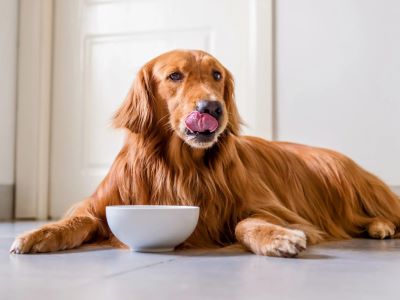Be it pasta, chicken or soup there are a lot of dishes that enhance their taste just by adding pesto. Pesto is a regularly used paste in many households. For the people fostering dogs, the tension rises when your dog is more interested in your food. During such a situation, the question arises, “Can dogs eat pesto?”
Through our blog, we will try to resolve your query and provide you with the required information.

What Is Pesto?
The history of pesto lies deep within the roots of ancient Romans. The people of ancient Romans used to eat ‘Moretum’ a paste similar to pesto. The word pesto is derived from the Genoese verb ‘Pesta’ which means to be crushed.
Crushed garlic, pine nuts, coarse salt, cheese and basil leaves are all together blended in olive oil to make a paste. This paste is called pesto and is used as a topping for mostly pasta, vegetables, fish or bread.
Can Dogs Eat Pesto?

No, dogs cannot eat pesto. Pesto being a human food is not good for dogs and may affect their health adversely. Pesto contains garlic and garlic is toxic for dogs. Consumption of garlic or garlic-added food can lead to anaemia and gastrointestinal issues in your dog.
Apart from garlic pesto contains cheese and oil. Cheese to some extent is safe for your dog but oil is a big no for dogs. Vegetable and sunflower oil are rich in fat and full of calories, which will have a negative effect on dog’s health.
Pesto of any colour green or red is not meant to be consumed by dogs. Both the colour pesto are equally dangerous for dog’s health. Not just garlic any herb belonging to the allium family[1] is toxic for dogs.
As mentioned by Veronica Higgs, DVM in petmd, "Onions belong to the genus Allium, and their scientific name is Allium cepa (cepa is Latin for “onion”). They contain a toxic compound, N-propyl disulfide, that damages red blood cells, which leads to their breakdown and destruction. This process, called hemolysis, results in anemia and red or brown discoloration of urine. With anemia, the body’s organs are no longer getting enough oxygen. In severe cases, this can result in organ failure and death."
Symptoms of Garlic Toxicity in Dogs

If your dog has mistakenly consumed the pesto then look for the following garlic toxicity symptoms:
- Pale gums: Due to the consumption of garlic blood circulation in dogs becomes improper. This hindrance in blood circulation results in pale gums in dogs.
- Rapid breathing: Garlic toxicity results in rapid breathing in dogs. The lack of oxygen due to improper blood circulation results in an increase in heart rate and rapid breathing in dogs.
- Lethargy: The lack of oxygen and blood makes the dog weak and lethargic.
- Anaemia: The lack of blood and oxygen leads to anaemia in dogs. Due to anaemia, the dog suffers from severe weakness.
- Gastrointestinal issues: The major effect of garlic poisoning can be seen in a dog’s digestive tract. Due to garlic poisoning, the dog suffers from gastrointestinal issues like diarrhoea and vomiting. These gastrointestinal issues occur due to the inflammation caused in the intestine due to garlic.
- Collapse: The lack of oxygen in dogs can result in them collapsing and even worse situations like a coma.
- Seizures: The toxins of garlic affect the dog’s neurological process and cause damage to them. Seizures further occur due to this damage. Seizure being an irreversible condition affects the dog’s entire lifestyle.
- Hematuria: Hematuria is a condition in which there is the presence of blood in a dog’s urine. The consumption of garlic damages the dog’s kidney and breaks the red blood cells. In this condition of Hematuria, the dog’s urine is of red and brown colour.
What Should You Do if Your Dog Eats Pesto?
Here is what you should do if your dog eats pesto:
- If your dog has consumed the pesto then look for the garlic positioning symptoms and consult a vet immediately.
- Contact a pet poison helpline and provide them with all the necessary details so they can guide you with further procedures.
- Try administrating activated charcoal this will help in reducing the poisoning effect.
- Keep your dog hydrated, garlic poisoning leads to gastrointestinal issues and lack of oxygen in a dog, this reduces the water level of the dog’s body. The situation of dehydration will only worsen the prevailing situation thus it becomes important to provide a dog with fluid constantly.
Alternative to Pesto for Dogs

Here are some of the safe alternatives to pesto for dogs that you can consider feeding your dog:
Mashed sweet potato
Sweet potato is a healthy source of carbohydrates, fibre and Vitamin A. By boiling and then smashing it you can serve your dog a healthy and tasty meal. Sweet potato is easy to digest and does not lead to any negative effects. Apart from this sweet potato is food for dogs suffering from diarrhoea.
Carrot
Carrots are rich in vitamin A, fibre and beta-carotene. Carrot in both raw and cooked form is eatable and best for dogs. It is a crunchy treat and even helps your dog to clean the teeth.
Blueberries
Blueberries are not just good for enhancing dog’s taste but also provide dogs with a lot of health benefits. Being rich in antioxidant blueberries helps to strengthen a dog’s immune system. They also help in preventing UTI (urinary tract infection) in dogs.
Plain cooked chicken
Chicken is a great source of protein and can be served boiled. You can add the boiled chicken to your dog’s regular meal or serve it plain too.
FAQs
Can dogs eat pesto?
No, dogs cannot eat pesto. Pesto is a human food and is not meant to be consumed by the dog. Pesto contains garlic and garlic being toxic to dogs can affect their health adversely. Eating pesto can lead to gastrointestinal problems in dogs. Apart from garlic, there are other harmful and non-dog-friendly ingredients in pesto.
Can I make dog-friendly pesto for my dog?
Yes, you can make a dog-friendly pesto for your dog. While making dog-friendly you have to avoid all the ingredients like oil or cheese which can harm your dog’s health. Dog-friendly pesto must consist of only herbs, and veggies, and low in sodium broth.
How much garlic is toxic to dogs?
The amount of garlic toxic to dogs depends upon the weight of the dog and the quality of the garlic. Normally garlic toxicity depends upon the ratio of 15 to 30 grams of garlic per kilogram of dog’s body weight. Garlic is toxic to dogs and should be avoided for dogs.
How can I prevent my dog from eating pesto?
To prevent your dog from eating pesto, you should keep it out of reach of your dog. Teach your dog basic commands so that the next time your dog goes near the unwanted things you can stop them. Train your dog to not go near any food items unless told to.
Can dogs eat red pesto?
No, dogs cannot eat the red pesto. Red pesto consists of sundried tomatoes to be the main ingredient which is safe for dogs. However, apart from the sundried tomatoes the red pesto also consists of onion, garlic, oil and cheese which are toxic for the dogs. These ingredients are not safe for dogs and should be avoided.
Conclusion
Pesto no doubt is the preferable choice for adding taste to our dishes but is not meant to be consumed by dogs. Dogs don’t know what is right for them to eat and what is not, but we surely do. We hope our blog, “Can dogs eat pesto?” has made you aware of the repercussions of dog-consuming pesto.
If your dog consumes pesto then consult a vet immediately or seek medical advice and guidance.
Reference:
- Guide to Poisonous Plants – College of Veterinary Medicine and Biomedical Sciences – Colorado State University. (n.d.).



